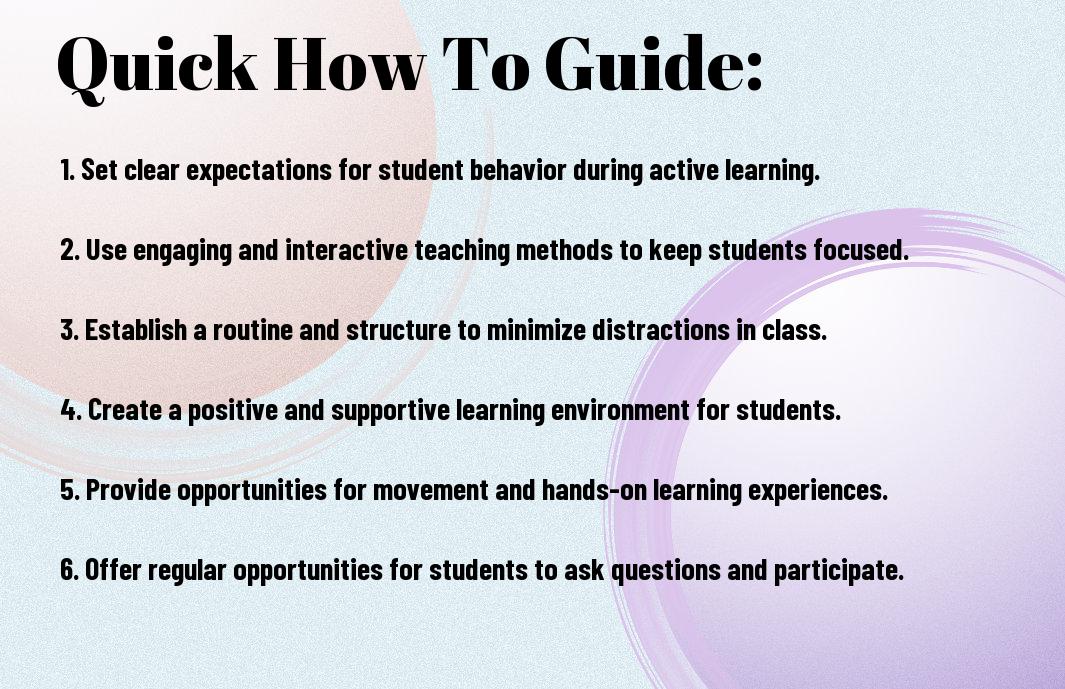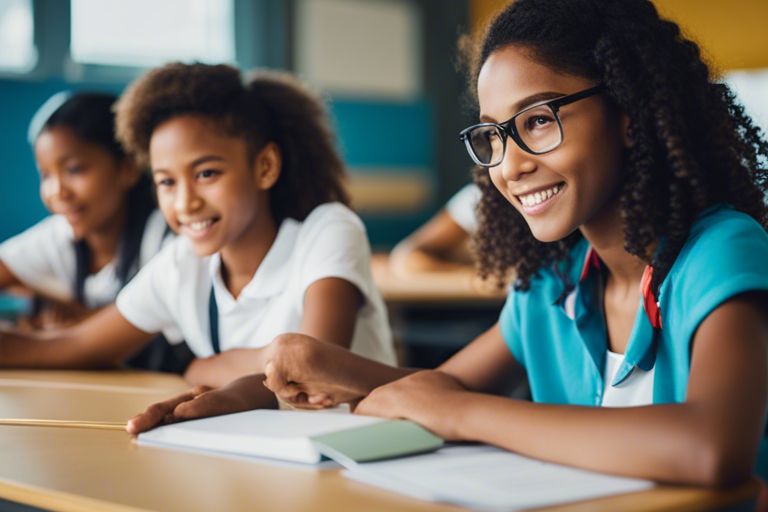How to Encourage Active Learning and Minimize Distractions in Middle School

Are you struggling to keep your middle school students focused and engaged in the classroom? It’s no secret that this age group can be easily distracted, making it a challenge for teachers to promote active learning. However, by implementing the right strategies and creating a conducive learning environment, you can encourage active learning and minimize distractions in your middle school classroom. In this blog post, we will discuss effective techniques that you can use to promote engagement and maintain a productive learning environment for your students.
One of the most important factors in encouraging active learning in middle school is creating an engaging curriculum. By incorporating hands-on activities, group discussions, and real-life examples into your lessons, you can capture your students’ attention and encourage interactive learning. Additionally, minimizing distractions in the classroom is crucial. By establishing clear expectations and procedures, and creating a clutter-free and welcoming learning environment, you can help your students stay focused and productive.
Key Takeaways:
- Engage with interactive activities: Incorporate hands-on activities and group work to encourage active participation and critical thinking.
- Implement clear expectations: Establish and communicate clear guidelines for behavior and classroom etiquette to minimize distractions.
- Utilize technology strategically: Integrate technology as a tool for learning, while also setting limits to prevent distractions.
- Provide a supportive learning environment: Foster a positive and inclusive atmosphere that promotes curiosity and collaboration.
- Offer personalized feedback: Provide individualized feedback and encouragement to motivate students and enhance their learning experience.

Understanding Active Learning
While traditional learning methods often involve passive listening and memorization, active learning requires you to engage with the material through various activities and discussions. This approach encourages you to think critically, ask questions, and apply what you’ve learned in real-life situations. By actively participating in the learning process, you are more likely to retain information and develop a deeper understanding of the subject matter.
Definition and Key Principles
Active learning can be defined as a hands-on, interactive approach to education that involves you in the learning process rather than just being a passive recipient of information. This method is based on several key principles, including collaboration, problem-solving, and critical thinking. Instead of passively absorbing information, you are encouraged to actively participate in discussions, group activities, and projects that require you to apply your knowledge in practical ways.
Benefits for Middle School Students
Implementing active learning strategies in middle school can have several benefits for you. First, it helps you to stay more engaged and focused during lessons, reducing the likelihood of distractions. Active learning also promotes a deeper understanding of the material by requiring you to analyze and synthesize information rather than simply memorizing facts. Additionally, this approach can enhance your critical thinking skills and problem-solving abilities, preparing you for future academic and real-world challenges.
Identifying Distractions
Your ability to identify and minimize distractions is crucial in creating an environment that fosters active learning in middle school students. By recognizing the different types of distractions students may face, you can better address them and support their focus on the learning material.
Common External Distractions
Common external distractions in a middle school environment may include noise from other classes, hallway traffic, or outside playground activities. These distractions can pull students’ attention away from the lesson and make it difficult for them to concentrate on the material being presented. Additionally, technology, such as smartphones and tablets, can also be a significant source of external distraction for students. It’s important to set clear guidelines for technology use during class time and provide alternative methods for accessing course material.
Internal Distractions and Their Impact
Internal distractions, such as anxiety, stress, or personal issues, can have a significant impact on a student’s ability to focus in the classroom. These distractions can manifest as wandering thoughts, difficulty concentrating, or emotional disturbances, all of which can hinder the learning process. It’s important to create a supportive and inclusive classroom environment where students feel comfortable discussing any personal issues that may be affecting their ability to stay focused. Additionally, teaching mindfulness and stress-reducing techniques can help students manage internal distractions and improve their concentration on the material being taught.
Preparation and Classroom Setup
For an active learning environment in middle school, it is essential to carefully prepare and set up your classroom to minimize distractions and encourage student engagement. The way you arrange the classroom, select furniture and tools, and organize supplies can significantly impact the learning experience for your students.
How to Arrange a Distraction-Minimized Classroom
When setting up your classroom, consider arranging desks or tables in a way that minimizes distractions. Avoid placing desks too close together, as this can lead to students being easily distracted by their peers. Also, ensure that the seating arrangement allows you to easily move around the room and provide individual support to students when needed. Furthermore, make sure to keep the areas around the classroom free from clutter or any unnecessary items that could divert students’ attention.
Selecting Appropriate Furniture and Tools
Choose the right furniture and tools for your classroom to create an environment that is conducive to active learning. Opt for ergonomic and comfortable seating options that promote good posture and allow students to focus on the lesson. Additionally, provide tools and supplies that are appropriate for the age group and subject matter being taught. Consider incorporating interactive whiteboards, visual aids, and other technology to enhance the learning experience and keep students engaged. The arrangement of your furniture and tools can play a crucial role in minimizing distractions and creating an environment that fosters active learning.
How to Encourage Active Learning and Minimize Distractions in Middle School
Teaching Strategies to Foster Active Learning
After setting the foundation for active learning in your middle school classroom, it’s important to incorporate effective teaching strategies that promote student engagement. One proven way to achieve this is by implementing collaborative learning techniques.
Incorporating Collaborative Learning Techniques
Collaborative learning encourages student interaction and engagement in the classroom. By working together on projects, group discussions, or problem-solving activities, students are able to learn from one another and develop important teamwork skills. When students are actively involved in the learning process, they are more likely to stay focused and avoid distractions. Encouraging teamwork and collaboration also creates a sense of community within the classroom, fostering a supportive environment for all students to thrive.
Tips for Individual Engagement in Classroom Activities
To further enhance active learning in your middle school classroom, it’s important to provide opportunities for individual engagement during classroom activities. Incorporating activities that allow for personal reflection and creativity can help students stay focused and make meaningful connections with the material. Some effective strategies for individual engagement include inquiry-based learning activities, independent research projects, and reflective journaling. Encouraging active listening and participation during class discussions also promotes individual engagement and minimizes distractions.
- Encourage teamwork and collaboration
- Provide opportunities for personal reflection and creativity
- Incorporate inquiry-based learning activities and independent research projects
Perceiving the needs of your students and actively involving them in the learning process is key to fostering an environment of active learning and minimizing distractions in your middle school classroom. By implementing effective teaching strategies and creating opportunities for both collaborative and individual engagement, you can empower your students to become active participants in their own education.
Technology and Active Learning
Despite the potential distractions that come with technology, it can be a powerful tool for facilitating active learning in middle school classrooms. When used effectively, technology can enhance engagement, collaboration, and critical thinking skills among students. It is important, however, to strike a balance and ensure that technology integrates seamlessly with the learning experience without causing disruptions.
How to Integrate Technology Effectively
Integrating technology effectively in the middle school classroom starts with choosing the right tools that align with your lesson objectives. Whether it’s utilizing educational apps, interactive presentation tools, or collaborative platforms, make sure that the technology enhances the learning process rather than serving as a mere distraction. Additionally, provide clear guidelines for how technology should be used in the classroom and communicate your expectations to students. Encouraging them to use technology as a research tool, a means of creative expression, or a way to access relevant course materials can help them stay focused and engaged.
Tools and Tips to Minimize Tech Distractions
When integrating technology, it’s important to minimize potential distractions that can divert students’ attention from the learning objectives. Consider utilizing features such as screen monitoring and classroom management software to manage and control students’ access to certain websites and applications. Encourage students to utilize tools such as ad blockers and browser extensions that help minimize distractions during their independent work. Additionally, establish clear guidelines for appropriate tech usage during class and provide support for students who may struggle with managing their digital distractions. Recognizing the potential for distraction and proactively addressing it will help create a more focused and productive learning environment.
Involving Parents and Guardians
Now that you understand the importance of involving parents and guardians in encouraging active learning and minimizing distractions in middle school, let’s discuss some effective strategies to foster a strong home-school partnership.
Communication Strategies to Foster Home-School Partnership
Effective communication is key to building a strong home-school partnership. Regularly keeping parents and guardians informed about their child’s progress, upcoming events, and expectations can help them stay involved and supportive of their child’s learning journey. Utilize various communication channels such as email, newsletters, phone calls, and parent-teacher conferences to keep the lines of communication open. Encourage open and transparent communication, so that parents feel comfortable reaching out with any concerns or questions they may have. Additionally, seek feedback from parents on how they prefer to receive information and adjust your communication strategies accordingly.
How Parents Can Encourage Active Learning at Home
Empowering parents to support their child’s active learning at home is crucial for reinforcing the lessons taught in the classroom. Encourage parents to create a dedicated study space at home where their child can focus on their schoolwork without distractions. Additionally, emphasize the importance of establishing a regular homework routine to help their child develop strong study habits. Encourage parents to participate in educational activities with their child, such as reading together or exploring educational websites and apps. By reinforcing the value of learning at home, parents can further enhance their child’s academic success.
Evaluating Progress and Adjusting Techniques
Unlike passive learning, active learning requires constant evaluation and adjustment to ensure student engagement and minimize distractions. It’s important to regularly assess the progress of your students and make necessary adjustments to your teaching techniques. This will help you keep your students engaged and on track, leading to a more productive learning environment.
Monitoring Student Engagement
One effective way to evaluate progress and adjust your teaching techniques is to consistently monitor student engagement. This involves observing how actively involved students are in the learning process. Are they participating in class discussions? Are they asking questions and seeking clarification when needed? These are all indicators of their level of engagement. You can also use tools such as quizzes, polls, or other interactive activities to gauge their understanding of the material. By regularly monitoring student engagement, you can identify areas where students may need additional support and adjust your approach accordingly.
When and How to Refine Your Approach
Knowing when and how to refine your approach is crucial for encouraging active learning and minimizing distractions in middle school. If you notice that certain students are consistently disengaged or struggling to grasp the material, it may be time to reassess your teaching methods. This could involve incorporating different instructional strategies, breaking down complex concepts into smaller, more digestible chunks, or providing additional resources for struggling students. Additionally, seeking feedback from your students can provide valuable insights into what is and isn’t working in your approach, allowing you to make the necessary adjustments.

Conclusion
Taking this into account, it is important to actively promote and encourage active learning while minimizing distractions in the middle school classroom. By implementing strategies such as incorporating hands-on activities, group discussions, and interactive learning tools, you can engage students and make the learning process more dynamic and enjoyable. Additionally, establishing clear expectations and routines, providing a well-organized and structured learning environment, and effectively communicating with students can help minimize distractions and create a focused and conducive atmosphere for learning.
Remember that your role as an educator is crucial in fostering an environment that is conducive to active learning and minimizing distractions. By implementing these strategies, you can help students develop important critical thinking skills, improve their ability to retain information, and ultimately enhance their overall academic performance.
FAQ
Q: What are some strategies to encourage active learning in middle school?
A: One effective strategy is to incorporate hands-on activities and group work into lessons. This helps to engage students and encourages them to actively participate in their learning. Additionally, providing regular feedback and encouragement to students can motivate them to stay engaged and take ownership of their learning.
Q: How can teachers minimize distractions in a middle school classroom?
A: Creating a structured and organized classroom environment can help minimize distractions. This includes setting clear expectations for behavior and implementing consistent classroom routines. Teachers can also reduce distractions by using technology strategically and creating designated spaces for students to work quietly or collaborate with their peers.
Q: What role do parents and caregivers play in encouraging active learning in middle school?
A: Parents and caregivers can support active learning by providing a positive and supportive home environment. This includes establishing a designated study area for their child, setting aside time for homework and studying, and showing interest in their child’s education. Open communication with teachers and involvement in school activities can also reinforce the importance of active learning at home.